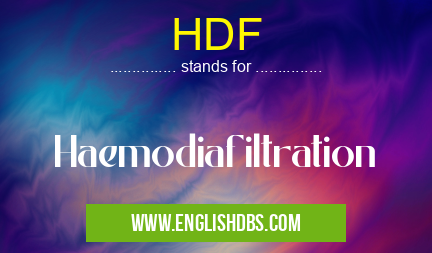What does HDF mean in MEDICAL
Haemodiafiltration (HDF) is a renal replacement therapy used in the treatment of end-stage renal disease (ESRD) patients. It combines the principles of haemodialysis and haemofiltration to provide a comprehensive and effective method of removing waste products and excess fluid from the blood.

HDF meaning in Medical in Medical
HDF mostly used in an acronym Medical in Category Medical that means Haemodiafiltration
Shorthand: HDF,
Full Form: Haemodiafiltration
For more information of "Haemodiafiltration", see the section below.
Principle
HDF operates based on the principle of convective transport, where fluid and solutes are removed from the blood by forced ultrafiltration across a semipermeable membrane. This process allows for the clearance of both small and medium-sized molecules, including uremic toxins and excess fluid.
Procedure
HDF is typically performed using a dialysis machine. Blood is withdrawn from the patient's body and passed through a dialyzer, which contains a semipermeable membrane. As the blood flows through the dialyzer, waste products and excess fluid are removed by convection. The filtered blood is then returned to the patient's body.
Benefits
HDF offers several benefits over conventional haemodialysis:
- Enhanced Clearance: HDF effectively removes both small and medium-sized molecules, providing a more comprehensive clearance of uremic toxins.
- Reduced Inflammation: HDF has been shown to reduce inflammation by removing pro-inflammatory cytokines and mediators.
- Preservation of Residual Renal Function: HDF helps preserve residual renal function by reducing the accumulation of toxins and allowing for some natural filtration by the kidneys.
- Improved Hemodynamic Stability: HDF maintains hemodynamic stability by avoiding large fluctuations in blood pressure and volume.
Essential Questions and Answers on Haemodiafiltration in "MEDICAL»MEDICAL"
What is HDF (Haemodiafiltration)?
HDF is a type of renal replacement therapy used to remove waste products and excess fluid from the blood in patients with kidney failure. It combines hemodialysis (HD) with hemofiltration (HF), allowing for more efficient removal of middle molecules and uremic toxins.
How does HDF work?
In HDF, blood is passed through a semipermeable membrane that separates waste products and fluids from healthy blood cells. While HD uses only diffusion to remove waste, HDF combines diffusion with convection, creating a larger volume of fluid removal and better clearance of toxins.
What are the benefits of HDF over HD?
HDF offers several advantages over traditional HD:
- Enhanced removal of middle molecules and uremic toxins
- Improved blood pressure control
- Reduced inflammation
- Lower risk of cardiovascular complications
- Potential for longer dialysis intervals
Who is a suitable candidate for HDF?
HDF is generally recommended for patients with:
- Severe kidney failure
- High levels of uremic toxins
- Fluid overload
- Cardiovascular instability
- Diabetes or other comorbid conditions
What are the potential risks of HDF?
Like any medical procedure, HDF carries some potential risks, including:
- Hypotension (low blood pressure)
- Electrolyte imbalances
- Hypothermia
- Hemolysis (destruction of red blood cells)
- Infection
How often is HDF performed?
The frequency of HDF treatments varies depending on the individual patient's needs. It is typically performed 2-3 times per week, with each session lasting approximately 4-6 hours.
Final Words: HDF is an advanced renal replacement therapy that provides effective clearance of waste products and excess fluid in ESRD patients. Its benefits include enhanced clearance, reduced inflammation, preservation of residual renal function, and improved hemodynamic stability. As a result, HDF is increasingly becoming a preferred treatment option for ESRD patients.
